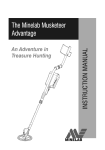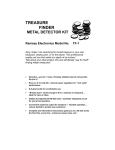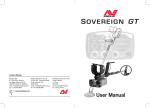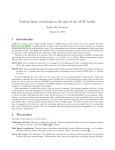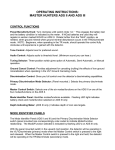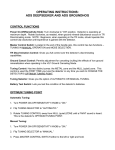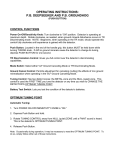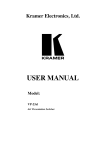Download Fisher M-SCOPE 1236-X2 User's Manual
Transcript
QUALITY Fisher detectors are renowned for their quality. In the Fisher tradition, each detector is hand crafted with pride 1236-X2 Silent, Discriminating Metal Detector PERFORMANCE Treasure Hunters worldwide rely on Fisher. Our detectors are durable, dependable, and search deeper.. REPUTATION Fisher produced the first patented metal detector in 1931. For over 70 years, the Fisher logo has been a mark of excellence. 5 - YEAR LIMITED WARRANTY Fisher believes in the products we produce and backs this belief with a 5 year limited warranty. Warranty may vary outside of the United States. See your dealer for details SERVICE Fisher is committed to providing you, our valued customer, with superior service. Each and every instrument is rigidly tested and carefully inspected during assembly and before shipment. Should you have any questions or problems, contact: FISHER RESEARCH LABORATORY 200 West Willmott Road., Los Banos, California 93635 Tel 209.826.3292 Fax 209.826.0416 www.fisherlab.com email:[email protected] Operating Manual FISHER RESEARCH LABORATORY FRL8704810-D 1236x2 manual-8704810.indd 1 6/9/06 10:08:56 AM CONTENTS About Your 1236-X2................................................................. pg. 3 Condensed Operating Instructions........................................ pg. 6 Setting Up.................................................................................. pg. 7 Body or Hipmounting............................................................... pg. 9 Control Functions...................................................................... pg. 10 Discrimination Points................................................................ pg. 12 Searching.................................................................................. pg. 14 Pinpointing................................................................................ pg. 16 No-Motion Pinpoint Mode....................................................... pg. 16 Pinpointing in the Motion Search Mode................................. pg. 17 Target Recovery....................................................................... pg. 18 Recovery Tools.......................................................................... pg. 18 Operating Tips........................................................................... pg. 19 False Signals.............................................................................. pg. 20 Battery Replacement............................................................... pg. 22 Maintenance............................................................................ pg. 23 Treasure Hunter’s Code of Ethics............................................ pg. 23 Where to Use Your Metal Detector in the U.S......................... pg. 24 Specifications........................................................................... pg. 25 1236x2 manual-8704810.indd 2 6/9/06 10:08:56 AM ABOUT YOUR DETECTOR SPECIFICATIONS NOTES 1. Subject to improvement or modification without notice. 2. In Search Mode, the 1236-X2 operates under two modes of discrimination. With the SILENCER off, it operates in a classic 2nd derivative discrimination mode that allows all pops, clicks and partial target responses to be heard for maximum target information. With the SILENCER on, the 1236-X2 operates in 3rd derivative SILENCER mode. This is especially useful for eliminating noise in extremely trashy areas. 3. The Search Mode has a 416 Hz target response. The Pinpoint Mode has a Voltage Controlled Oscillator (VCO) target response that responds to the precise location of a target with increasing volume and pitch. 4. A slight audio threshold is provided in Search Mode when the SENSITIVITY control is set to its maximum setting. This aids in detecting the faintest of target signals. 5. Approximate. 6. Electro-Static-Insulated to eliminate certain types of false signals. 7. The transmitter frequency is centered nominally at 5.7 KHz and is user adjustable from 5KHz to 5.9 KHz to eliminate interference from nearby detectors. 26 1236x2 manual-8704810.indd 3 Your 1236-X2 was designed to do one thing well, provide all the quality tools necessary to help you find good, deep targets in trashy or mineralized soil with minimum hassle. The 1236-X2 does this by providing you a wealth of powerfully, well designed instrument controls and features that give you maximum flexibility of adjustment to accommodate your unique style of detecting. These are the controls on your 1236-X2 . Sensitivity Control: Along with an increase in sensitivity to find those deeply buried targets, we’ve provided a versatile SENSITIVITY control to adjust the sensitivity when searching near large metallic objects or extremely trashy areas. At the maximum SENSITIVITY setting a slight amount of audio threshold is provided so the faintest of target signals can be heard. Dual Mode Discrimination: The 1236-X2 provides two powerful modes of discrimination for you to choose as you hunt in different environments. In both discrimination modes you can adjust the DISC control to accept certain types of metallic targets while simultaneously rejecting ground minerals, trash, and other less conductive metallic targets. With the SILENCER switch “off” the 1236-X2 operates in a classic 2nd derivative discrimination mode that allows all pops, clicks, and partial target responses to be heard for maximum target information. With the SILENCER switch “on” the 1236-X2 operates in a newly developed 3rd derivative SILENCER mode, eliminating all pops, clicks, and partial target responses for a quieter mode of operation. This mode of discrimination is especially useful for eliminating excessive pops and clicks heard when searching in extremely trashy areas. 3 6/9/06 10:08:56 AM ABOUT YOUR DETECTOR Search Mode Motion Circuitry: In this mode of operation the motion circuitry in the 1236-X2 responds with a 416 Hz tone as the search coil is moved over a target. This makes the 1236-X2 less sensitive to soil mineralization and false target responses associated with the temperature drift and aging of electronic components. No-Motion Pinpoint Mode With VCO Audio: At the push of a button, the all-metal no-motion pinpoint mode kicks in with VCO (Voltage Controlled Oscillator) audio response for precise target locating. A located target responds with increasing volume and pitch. The tone gets louder and higher, so there’s virtually no doubt when you’re directly over a target. VOLUME Control: For an extra measure of versatility, we’ve included a VOLUME control so you can set the audio level to suit your needs. You’ll no longer have to buy a special headset with extra controls to adjust the audio level. FREQUENCY Control: You can vary the transmit frequency of your 1236-X2 from 5.5 KHz to 5.9 KHz. This control allows you to eliminate electrical interference from nearby metal detectors. A must for competition hunting. User Setpoints And Factory Presets: The SENSITIVITY, VOLUME, FREQUENCY, and DISC controls all have recommended user setpoints that are indicated by a red-colored number on each control’s number dial. These setpoints provide a useful starting point for the new user. In addition, we’ve included a convenient factory preset IRON discrimination setting. When the DISC control is fully rotated counterclockwise to the IRON position, the 1236-X2 is set to reject common iron trash and nails. 4 1236x2 manual-8704810.indd 4 SPECIFICATIONS Operating Modes Search (Motion Mode) .........................................VLF 2nd Derivative2 VLF 3rd Derivattive SILENCER MODE Discrimination2 Pinpoint (No-Motion Mode).............................................VLF All Metal Audio Response3.................. Search Mode................................416 Hz Pinpoint Mode............................................................................... VCO Audio Threshold4............................................................................... Yes Volume Control................................................................................. Yes Transmitter Frequency . ..............................................................5.7 KHz Length5.......................Extended 55 inches ........Collapsed 46 inches Weight6............................................................................................ 3 lbs. Search Coil .......................... Type.................. Concentric, Co-Planar ............................................... Diameter....................................8 inches ............................................... Shielding................................ 100%E.S.I. 6 ............................................... Interchangeable............................... Yes ............................................... Waterproof......................................... Yes ............................................... Cable Length.................................7 feet Sensitivity Control.............................................................................. Yes Discrimination Control...................................................................... Yes Frequency Control7. ......................................................................... Yes Automatic Ground Rejection ......................................................... Yes Handle Mount.................................................................................... Yes Hip-Mount Convertible Built-In Arm Rest & Detector Stand................................................. Yes Stereo Headphone Jack.................................................................. Yes Batteries ........................................................................(2) 9V transistor Battery Life.............Carbon Zinc 20-30 hours......Alkaline 40-50 hours CE Compliant For Export 25 6/9/06 10:08:56 AM Where To Use Your Metal Detector In The U.S. National Forest and Federal Lands—Metal detecting is allowed only by special permit acquired from the federal government. Each area has a district office. Corps of Engineers, Lakes, Shorelines and Lands—Permission has been granted only on predisturbed sites, such as beaches and attached swimming areas. New Corps lakes and lands must be okayed by the main office of the Army Corps of Engineers. Each area has a district office. State Parks and Lands—Some state parks are open to metal detecting, but some are not. Always check with the park ranger before attempting to use your detector. Bureau of Land Management (BLM) Lands—Some areas are open for metal detecting, and some are not. Always check with the district office. City or County Park Lands—Most are open to metal detecting unless notice is given by a sign or city ordinance. When in doubt, always check with the city’s Parks and Recreation Department. Public School Grounds—Most are open to metal detecting unless notice is given by a sign, city ordinance, law enforcement official, or school employee. You should always check with the school office first. Privately Owned Lands (Private Property)—Permission required. And it is always best to have the permission in writing. Historically Marked Lands or Sites—Metal detecting is not ABOUT YOUR DETECTOR Battery Test: A convenient battery test switch has been incorporated into your 1236-X2 to check the relative strength of the batteries. Rotating the SENSITIVITY control counterclockwise to the “BATTERY” position causes the 1236-X2 to give off an audio tone with the intensity indicating the strength of the battery. A low or absent audio tone indicates a weak or dead battery. Built with the latest high-tech digital and analog surface mount circuitry, it all adds up to one great state-of-the-art metal detector with loads of versatile features. Treat it as you would any fine instrument and you’ll be rewarded with years of quality service and who knows how many treasures. If you have any questions, suggestions, or interesting 1236-X2 stories, drop us a line. In the meantime... Happy Hunting! Fisher Research Laboratory allowed. Don’t even think about it. 24 1236x2 manual-8704810.indd 5 5 6/9/06 10:08:57 AM CONDENSED OPERATING INSTRUCTIONS MAINTENANCE Using the 1236-X2 is simple, but you’ll have more fun and a better chance of making that BIG find if you have a complete understanding of what you’re doing and why. That’s why we recommend that you read the entire manual first. But if you just can’t wait any longer or you’ve already used a Fisher “X” detector, here’s some quick instructions: Your 1236-X2 doesn’t require a lot of care, but there are a few things you should do to keep it in peak operating condition. 1. If you’re not going to be using it for awhile, take the batteries out. Acid damage caused by leaking batteries can be severe. 2. Avoid extreme temperatures, like inside a closed car that’s sitting in the sun. Even worse, inside the trunk in the hot sun. 3. If you “scrub” the search coil on the ground, you’ll eventually wear through the bottom. Replacement coils are expensive. Instead, invest in a coil cover. They’re cheap. 4. Put a plastic bag over the control housing if you’re hunting in rain, fog or dust. 5. Keep your 1236-X2 dry and clean. Wipe off the lower stem before sliding it into the upper stem and keep the slip nut threads free of sand and dirt. 1. Set the controls as follows: FREQUENCY = 0 (center frequency = 5.7 KHz) SENSITIVITY = 8 DISC = 4 SILENCER = ON VOLUME = 5 2. Turn the unit on by turning the VOLUME Control to 5. 3. Set the DISC Control to 4. As soon as you set the DISC control, your 1236-X2 is automatically tuned and ground adjusted for searching. 4. The Search mode (which you’re in) is a VLF-motion discrimination mode. It will ignore ground minerals and junk, but you’ll have to keep the search coil moving at least slightly to detect a target. 5. With practice you should be able to pinpoint in the Search mode. Set SENSITIVITY to 8 Set DISC to 4 Set VOLUME to 5 Set FREQUENCY to 0 (center) Set SILENCER to ON Figure 1. Recommended user setpoint locations. 6 1236x2 manual-8704810.indd 6 TREASURE HUNTER’S CODE OF ETHICS LETS PRESERVE OUR TREASURED SPORT! Laws governing the use of metal detectors are becoming more and more common. In many countries, the use of metal detectors is illegal or severely restricted. Don’t let this happen in your area. ALWAYS get permission to hunt on private property. ALWAYS leave a site cleaner than you found it. Take at least some trash with you or, if you can, take it all. ALWAYS fill in your holes neatly whether you’re in a city park or remote wildernessness. Leave the land as it was before you disturbed it. ALWAYS obey all laws relating to Treasure Hunting. ALWAYS return valuable property if you can locate the original owner. ALWAYS do whatever you can to give the hobby of Treasure Hunting the good image it needs and deserves. 23 6/9/06 10:08:57 AM BATTERY REPLACEMENT SETTING UP Two 9-volt transistor batteries are located in separate compartments at the rear of the housing of the 1236-X2. When it’s time to replace the batteries, always replace both of them. Your new 1236-X2 is just about ready to go, but take a look at the following illustration before proceeding. 1. To open the battery compartments, press gently down and out on the battery door latch. The doors are tethered; do not attempt to completely remove them. 2. Tilt the housing gently and the batteries will slide out. 3. Insert the new batteries. Make sure the contact end goes in first and that you match the polarity markings on the control housing. 4. To close, simply hook the lower edge of the battery door over the inside of the battery compartment and gently push shut. Battery replacement is simple with the 1236-X2’s drop-in battery compartments: just pop the doors open, slide the old batteries out and drop the new ones in. Figure 10. Battery replacement 22 1236x2 manual-8704810.indd 7 1. Unpack your 1236-X2 carefully, and save the carton: it may come in handy if you ever have to return the instrument for service. Control Housing Speaker Control Panel Cable connector and battery compartments (on back) Search cable Search coil Headphone Jack Arm rest Hand grip Search coil wing nut Upper Handle Lower stem Spring Lock Built-in Detector Stand Lock nut Velcro® straps Figure 2. 1236-X2 2. Slip the lower stem into the upper handle. 3. With the search coil cable still disconnected from the control housing, adjust the stem length and coil angle so that the search coil rests flat on the ground about 6 to 12 inches in front of and slightly to the right of your right foot (to the left of your left foot for left handers). The stem length is adjusted by loosening the lower lock nut and allowing the spring lock to snap into one of the holes in the upper handle. The coil angle is adjusted by loosening the nylon wing nut on top of the search coil. NOTE: Your arm should be straight and relaxed with the hand grip held comfortably (not tight). 7 6/9/06 10:08:57 AM FALSE SIGNALS SETTING UP Remember, the longer the shaft, the greater the strain on your arm and wrist. The 1236-X2 is balanced for comfortable searching in a tight semicircle around the front of the operator. 4. Hand tighten the lock nut and search coil adjusting wing nut. 5. With the stem length properly adjusted, wrap the search coil cable snugly around the upper handle and secure it with velcro straps. Leave just enough slack near the coil to allow it to be tilted completely backward and forward. NOTE: A loose cable near the search coil may cause false signals, but don’t wrap it so tightly that it pulls against the housing or the coil. 6. Reconnect the search coil cable to the control housing. Be careful not to cross thread it and make sure it’s snug but hand tighten only. 7. With the shaft length and coil angle properly adjusted, lean forward slightly and raise your arm until the coil is about 2” above (and parallel to) the ground, 6-12 inches in front of your foot. 8. If you’re using headphones, plug into the headphone jack on the control panel. 5. Elongated Ferrous Objects: If you hear two beeps very close together and can’t find either one, you’re probably over a nail or some other large object. But a very shallow coin or a coin on edge will give the same response. SOLUTIONS: In all cases, the target will be between the beeps, or if you sweep at right angles to your original direction, you’ll receive a single beep directly over the target (except for a very shallow coin.) One way to tell the difference between a coin and a nail is to set the DISC control to the IRON setting. Most small nails will be tuned out while most coins will respond with a good, smooth signal. 6. Extremely Trashy Soil: May result in a constant chatter or “snap, crackle and pop” with assorted, hard-to-find “good signals.” SOLUTIONS: Increase the discrimination level. An even better solution is to engage the SILENCER feature, which virtually eliminates all signal chatter in trashy areas. For even further improvement, try the optional 5-inch soil. You’ll be able to zero in on good targets much closer to junk. 7. Digging Tool: If you’re carrying a digging tool in one hand, your 1236-X2 may sound off each time you swing the coil beneath it. SOLUTION: Hold your digging tool behind your back or up above your waist. False signals may also occur in the No-Motion Pinpoint mode. When in this mode (with the PINPOINT button pushed), the 1236X2 detects all metals, so you may pinpoint a piece of nearby junk instead of a good target. For this reason you should always recheck your target area after recovering any target to make sure that you haven’t missed anything. 8 1236x2 manual-8704810.indd 8 Figure 3. Search position You may also receive false pinpointing signals in highly mineralized soil. In this case, it is important to keep the coil parallel to the ground and at least an inch above it. 21 6/9/06 10:08:58 AM FALSE SIGNALS A “false signal” occurs when something that shouldn’t, sounds like a good target. Your 1236-X2 does an excellent job of ignoring junk, but it’s so sensitive to good targets that it can be fooled by bad targets with similar electrical characteristics. Large pieces of trash, for example, or even some kinds of bottle caps and pull tabs can fool you. Small pieces of trash less than 2 inches from the search coil will also sound good occasionally. So what do you do about false signals? Well, 90 percent of them will sound suspicious to you after you’ve had some experience, and you’ll just ignore them. They may be very faint or very abrupt with static. Often when you go back over the same spot, a false signal will simply disappear. Other false signals may be very loud and sharp, but most of these will disappear if the coil is speeded up or raised slightly. Some shallow, large or irregular pieces of junk, however, will fool the 1236-X2 no matter what you do. Here’s some other sources of false signals and what to do about them: 1. Detector Interference: Caused by nearby metal detectors operating at the same (or close) frequency. SOLUTION: Adjust the FREQUENCY control to the left or right of zero. 2. Electrical Interference: Caused by radio/TV stations, power lines, etc. SOLUTIONS: Move further away, lower the sensitivity, reduce the sweep speed. Try changing the FREQUENCY control position. Wrap the search coil cable tightly around the stem. 3. Highly Mineralized Soil: Usually causes constant static or good target sounds. SOLUTIONS: Lower the sensitivity, increase the discrimination. Raise the search coil until false signals disappear and sweep at that height. 4. Wet Sand: Same as highly mineralized soil. 20 1236x2 manual-8704810.indd 9 BODY or HIPMOUNTING 1. Disconnect the search coil cable from the control housing and unwind all but the last 12 inches or so from the upper handle. Secure the lower end of the cable with a Velcro® strap at least 12 inches up from the coil. 2. Remove the control housing from the hand grip by holding the grip with one hand and sliding the housing toward you with the other. 3. Attach your belt to the control housing by slipping it through the slots on the underside of the control housing. 4. Reconnect the search coil cable to the control housing. 5. The control housing can also be mounted on on the optional Fisher Chest Harness. It is especially important that the cable connector be installed tightly (hand tightened only) to prevent false signals during body-mount use. Note: For belt mounting, left handers should wear the housing on their right hip and right handers should wear it on their left hip. Once removed from the stem, the control box can be hip or chest mounted leaving only the stem and search coil to swing. 9 6/9/06 10:08:58 AM OPERATING TIPS CONTROL FUNCTIONS 1. SILENCER: When the toggle switch is flipped ON, the 1236-X2 runs in the 3rd derivative SILENCER discrimination mode, eliminating the annoying “pops” and “clicks” heard when searching in extremely trashy areas. Flipping it to OFF, the 1236-X2 runs in classic 2nd derivative discrimination mode. 2. DISC: This control sets the discrimination level. At a setting of 0, all types of metal are detected. At higher settings, less conductive objects and trash are rejected. When the DISC control is fully rotated (counterclockwise) to the IRON preset, the 1236-X2 is set to reject common trash and nails. Note: The DISC Control has no effect in PINPOINT mode. 3. SENSITIVITY: This control adjusts sensitivity to targets and ground minerals. The higher the setting, the deeper you’ll detect. However, you will also pick up more false signals in highly mineralized or trashy soil. At a setting of 10, a slight amount of audio threshold is provided so the faintest of targets can be heard. At the BATTERY setting, a battery test tone is sounded. A loud tone indicates good batteries. A faint tone 4 5 3 6 2 1 10 Figure 5. Control panel 1236x2 manual-8704810.indd 10 1. We’ve already said it, but it bears repeating: TAKE YOUR TIME AND OVERLAP YOUR SWEEPS. 2. Use good headphones. You won’t miss faint targets, you won’t attract unwanted attention and you won’t bother others. 3. Practice pinpointing. There’s nothing sacred about the methods described in this manual. Many 1236-X2 users have developed their own pinpointing methods. 4. Always BURY A COIN when working in unfamiliar territory, and check it at different discrimination and sensitivity levels. There may be some sensitivity loss at higher levels of discrimination. The greater the ground mineralization, the higher the sensitivity loss. For example, you may be able to detect a penny at 6 inches with zero discrimination, but no deeper than 4 inches at the pull-tab discrimination point. 5. The 1236-X2 is an easy detector to use, but if you’re having trouble with any aspect of its operation (pinpointing, searching, false signals, etc.) go back and reread the part of this manual relating to your problem. 6. If a target gives a strong response in the search mode but no response in the NO-Motion Pinpoint mode, you may have “tuned out” your target (and all others) by pushing the PINPOINT button over another piece of metal. If you suspect this may be the case, move the search coil to another spot before pressing the PINPOINT button again. 7. When in doubt about the possible identity of a target, dig it up. 7 19 6/9/06 10:08:58 AM TARGET RECOVERY Once you have pinpointed a target, your objective is to recover it quickly and neatly, leaving virtually no trace of your excavation. There are almost as many ways to do this as there are treasure hunters. Whatever works for you is good enough as long as you don’t break any laws, damage vegetation, or leave your search area looking like a World War II battlefield. Generally speaking, beachcombers do little if any damage to the environment while recovering targets. However, if you plan to use your 1236-X2 on lawns or in parks, your target recovery method can be very important. Two of the most successful methods are illustrated in a separate booklet enclosed with your 1236-X2. NOTE: Whichever tool or method you choose, remember that responsible treasure hunters take pride in their ability to leave soil and vegetation intact and undamaged. RECOVERY TOOLS 1. A heavy duty, blunt screwdriver is commonly used by expert treasure hunters. 2. A sturdy hunting knife with a 5-inch blade will do the job in most soils. A high quality double edged “survival” knife is an even better (and more expensive) choice since it will be almost impossible to bend or break. CAUTION: Using a jack knife without a locking blade is a good way to lose a finger! 3. A narrow garden trowel will work in loose or wet soil. 4. Several excellent digging tools are made just for the treasure hunter, and specially designed sand scoops are available for beachcombing. 5. A thin, dull probe is the preferred tool for precise target location. 18 1236x2 manual-8704810.indd 11 CONTROL FUNCTIONS indicates weak batteries and no tone means that it’s time for a battery change. 4. VOLUME: This control switches the 1236-X2 on and off and controls the volume of the audio response. A setting of 10 provides maximum audio signal volume. 5. FREQUENCY: This control changes the operating frequency of the 1236-X2 to eliminate interference from nearby detectors. Set it at 0 for normal operation. To eliminate signal interference (usually a pulsing or “motor boating” sound) simply increase it (+) or lower it (-) slightly. Do not operate at a higher or lower frequency level than necessary as you may experience a slight loss of depth in highly mineralized ground. 6. HEADPHONES: This jack accepts most stereo and mono headphones with quarter inch plugs. Set your headphone to stereo. 7. PINPOINT: When pushed and held, this button switches the 1236-X2 into the No-Motion, AllMetal Pinpoint mode. A located target responds with increasing volume and pitch. Under certain conditions, you may get inter ference from a nearby detector in the Pinpoint mode but not in the Search mode. In this case, release the PINPOINT button and reset the FREQUENCY Control to another noninterference position. Do not adjust the FREQUENCY Control while the PINPOINT button is pushed in. 11 6/9/06 10:08:59 AM DISCRIMINATION POINTS PINPOINTING IN MOTION SEARCH MODE By adjusting the DISCRIMINATION Control, you will be able to ignore (or “reject”) small pieces of metallic trash and ground minerals while detecting valuable targets. The lowest setting at which an object is rejected is referred to as its “discrimination point.” Discrimination points are determined by such factors as size, shape, depth, type of metal and ground mineralization. 1. Scatter some sample targets, such as coins, pull tabs and small pieces of foil on the ground 1 to 2 feet apart. 2. Turn the 1236-X2 on by turning the VOLUME control clockwise to 5. 3. Set the SENSITIVITY Control to 8. 4. Set the FREQUENCY Control to 0. 5. Set the DISC control to the IRON present position. 6. Hold the search coil in the air, away from any metal objects, and check the batteries as explained in the Control Functions section. (See SENSITIVITY, p. 9.) 7. Hold the search coil about 2 inches above and parallel to the ground. Move it slowly over the samples and note the sharp, loud response as you pass over each one. Keep in mind that the 1236X2 is a motion detector in the DISC mode and responds only when the search coil (or the target) is moving. 7. Increase the DISC control to a setting of 3 and again pass over the targets. Repeat this process at settings of 4, 5, 6 and so on to 10. You will note that as you increase the level of discrimination, the 1236-X2 rejects some targets and continues to respond to others. You have now determined the discrimination points for the rejected objects. For example, the small nail discrimination point may be at 3 and the pull tab discrimination point at 7. 8. Some objects such as shallow bottle caps, bent pull tabs or trash less than 2 inches from the coil may be difficult to reject. The 1236-X2 will instead respond with a strong broken signal, which will usually disappear if the search coil is raised slightly. (whereas, the strong signal of a good target will usually get weaker when the search coil is raised.) Pinpointing in the Search Mode will take a little practice, but you may find that for most targets it’s even quicker than the No-Motion Pinpointing Mode. Simply use the same procedure as in steps 2 through 5 on p. 14. The only difference will be that when you stop the coil over the target you will lose the audio signal. You must keep the coil moving at least slightly to determine the location of the strongest signal before you stop it. 1. For very strong signals, you may improve your motion mode pinpointing accuracy by adding one or more of the following steps: a. Lift the coil until the signal is just barely heard. b. Reduce the sensitivity level. c. Increase the discrimination level. d. Rest the coil on the ground and move it back and forth very slowly. 2. For very weak signals try the following: a. Move the coil closer to the ground. b. Increase the sensitivity level. c. Decrease the discrimination level. d. Speed up the sweep rate slightly. 12 1236x2 manual-8704810.indd 12 1. Minimum Depth a. Very slow or very fast sweep speed. b. Discrimination set at 10. 2. Good Depth a. Moderate sweep speed. 1 b. Discrimination set at 5. 2 3 4 Figure 9. Search coil detection pattern 3. Maximum Depth a. Moderate sweep speed. b. Discrimination set at 10. 4. Missed target NOTE: Many targets within the range of your 1236-X2 will not be detected unless you closely overlap your swings. 17 6/9/06 10:08:59 AM PINPOINTING DISCRIMINATION POINTS The pinpoint mode requires no tuning and no motion to precisely locate the target. With the Pinpoint push-button depressed, the 1236-X2 is in an all-metal mode, meaning that any discrimination setting you might have selected will no longer apply. The VCO (Voltage Controlled Oscillator) circuitry indicates the presence of a target by increasing both the volume and frequency of the audio output. By depressing the Pinpoint push-button, precise target location is a snap. NO-MOTION PINPOINT MODE 1. Once the presence of a buried target is indicated by the “beep-beep” simply place the coil lightly on the ground, away from the target area. Push the PINPOINT button and hold. (At maximum sensitivity you may hear a faint tone which will disappear as soon as the coil is raised.) 2. Raise the coil 1/2 inch or so and move it side to side across the target areas a few times. 3. Stop the search coil over the spot where you receive the loudest response. 4. Now move the coil slowly forward and back a couple of times, again stopping over the strongest response. 5. Move the search coil side to side one more time and stop over the strongest signal once again. Your target should be directly below the “Hot Spot” of the search coil. 6. For quick and accurate pinpointing of strong signals, place the coil on the ground very close to the approximate target area and push and hold the PINPOINT button. You have now “tuned out” most of the target signal so that when you raise the coil for pinpointing you will only receive a response directly over, or very nearly over, the target. 16 1236x2 manual-8704810.indd 13 Figure 6. Typical 1236-X2 audio reponses (with silencer off) for 2-inch deep targets with search coil sweeping 1 to 2 inches above ground 9. Some objects will cause sharp static or “ticking” when rejected. This is a perfectly normal response, with the SILENCER switched OFF. When the SILENCER is switched on, these “ticking” sounds are eliminated. 10. Large pieces of trash such as beer cans or jar lids may sound like a good target no matter what you do. With a little practice, however, you will be able to tell the difference between a large target and a small coin sized object. 11. The diagram above shows some different target responses you may expect at different levels of discrimination. Note that as you increase the discrimination level, you progressively eliminate more targets, including some good ones, such as nickels and gold rings. 13 6/9/06 10:08:59 AM SEARCHING SEARCHING Now comes the fun part if you follow a few simple rules. Good search techniques are every bit as important as a good detector. 1. The 1236-X2 has two operating modes. The “Search” mode is activated simply by turning the unit on. This is a “VLF-Motion Discrimination” mode that automatically ignores most ground minerals, rejects junk and works only when the search coil is moving. The “PINPOINT” mode is activated by depressing the PINPOINT button and will be explained later. 2. Set the FREQUENCY control at zero. 3. Adjust your SENSITIVITY control. Only experience will tell you how much sensitivity to use in any given situation, but start out at 8. NOTE: As a general rule, turn your sensitivity down to reduce excessive false signals caused by highly mineralized ground or interference caused by power lines, radio stations, etc. Turn it up if you want those deepest, smallest targets and you’re willing to put up with a few more false signals. 4. Decide how much discrimination you want to use. a. In relatively non-trashy soil use a low level of discrimination (2 for example) with the SILENCER OFF. In this manner the 1236-X2 will detect all metal targets 14 1236x2 manual-8704810.indd 14 Figure 7. Keep the search coil parallel and as close to the ground as possible. within its range and you can instantly increase the discrimination for further identification. b. In trashy areas you’ll probably want to operate at a higher level of discrimination (6 for example) with the SILENCER switched ON to cut down on the amount of time you spend digging bad targets. 5. Keep the search coil moving at a comfortable rate. Remember that the 1236-X2 is a motion detector and responds only when the search coil (or the target) is moving while in the Search mode. 6. Keep the coil parallel to, and as close to the ground as possible. Keep the search coil parallel to, and as close to the ground as possible. 7. Overlap your sweeps approximately 50 percent. 8. Search in a methodical manner, sweeping in a tight semicircle. Pay close attention to where you’re going and where you’ve been. 9. TAKE YOUR TIME. Also very important. If you walk too fast you can’t overlap your sweeps and you’ll miss a lot of ground. NOTE: If you sweep too fast, you’ll lose sensitivity and miss the deep targets. 10. The figure below shows the search coil detection pattern and how it is affected by sweep speed, discrimination level and overlapping sweeps in the Search mode. Figure 8. The 1236-X2 is balanced for sweeping in a tight semicircle. Always overlap your sweeps by at least 50% or you’ll miss a lot of the deeper targets 15 6/9/06 10:09:00 AM














